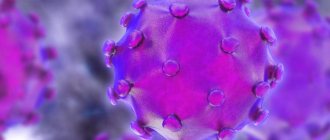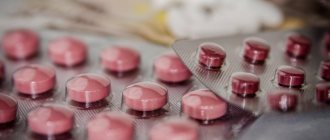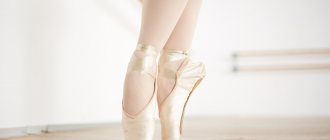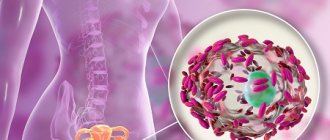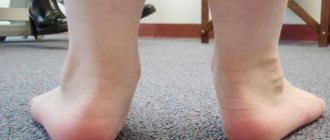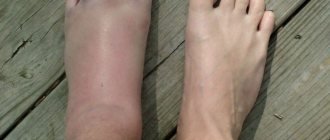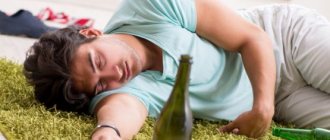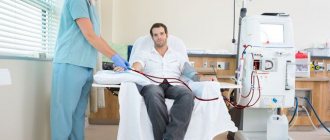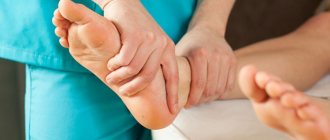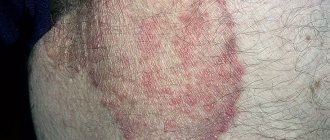Mycosis of the feet (ICD 10 code B35.3) is a fungal infection of the skin on the legs caused by parasitic dermatophytes. Occurs in approximately 20% of adults. Infection occurs through microtraumas, scratches, abrasions, wounds. The development of the disease is facilitated by wet feet, diabetes, and weakened immunity.
Among people with endocrine disorders and immunodeficiency conditions, the prevalence reaches 50%. More often the disease occurs in a chronic form with alternating periods of remission and exacerbations. In 40–50% of cases, athlete's foot causes onychomycosis or a fungal infection of the nails.
What is mycosis of the feet
Mycosis of the foot is a group of fungal skin diseases, often with simultaneous damage to the nails. These infections cause similar clinical manifestations. They can only be distinguished after a microscopic examination of the skin and nails. Mycosis of the feet is a highly contagious disease. It is transmitted from person to person through household items: rugs in locker rooms, showers and swimming pools, footstools, basins and flooring in baths and saunas. Sharing shoes and socks is dangerous. The surface layer of the skin, which is constantly peeling off, contains a lot of fungi and their spores. Initially, the interdigital folds are affected and skin itching occurs. Subsequently, the infection takes over the entire foot and spreads to the nails. The course of the disease is long-term and requires constant treatment. To prevent mycosis of the foot, in our online store you can buy an effective prophylactic product - Mycospray.
Prevention
Provides, firstly, for the disinfection of floors, wooden flooring, benches, basins, gangs in bathhouses, showers, swimming pools, as well as the disinfection of impersonal shoes; secondly, regular examinations of bath attendants and people working out in swimming pools in order to identify patients with epidermophytosis and their early treatment; thirdly, carrying out sanitary and educational work. The population needs to be explained the rules for personal prevention of athlete's foot: wash your feet every night at night (preferably with cold water and laundry soap), dry them thoroughly; change socks and stockings at least every other day; do not use someone else's shoes; Have your own rubber sandals or slippers for the bath, shower, pool.
To harden the skin of the soles, it is recommended to walk barefoot on sand and grass in the hot season.
Causes of mycosis of the feet
The cause of the disease is microorganisms of the genus Trichophyton, less commonly mold fungi and Epidermophyton floccosum:
- red trichophyton (Tr. Rubrum) causes up to 95% of all cases of the disease;
- approximately a third of patients also have interdigital trichophyton (Tr. Interdigitale);
- inguinal epidermophyton (E. floccosum) causes the disease in 1% of cases.
The likelihood of infection increases in unfavorable external conditions:
- high humidity;
- tight shoes;
- frequent visits to swimming pools, saunas and other wet areas;
- presence of a sick person in the family.
Some internal diseases also contribute to the development of fungal infections:
- sweaty feet;
- immunodeficiency;
- taking corticosteroid hormones orally;
- flat feet;
- Raynaud's disease, atherosclerosis of peripheral arteries, obliterating endarteritis, varicose veins;
- diabetes.
Atherosclerosis of leg vessels
According to statistics, a tenth of the population, mostly elderly, suffers from this disease. The most vulnerable are males over the age of 65 years. However, middle-aged people are also diagnosed with this disease. The insidiousness of atherosclerosis of the lower extremities lies in the fact that only ten percent of the total number of patients report the classic symptoms of this disease. It is worth considering that the mortality rate from atherosclerosis of the lower extremities is quite high : in the UK the mortality rate is 38, and in Russia this figure reaches 61%.
The degree of danger (death in some developed countries) is clearly demonstrated by the table, which presents WHO statistics (atherosclerosis of the legs in comparison with diabetes mellitus).
| Countries | Atherosclerosis of the legs,% | Diabetes,% | Annual losses of the country's budget, $ |
| Nigeria | 11 | 1 | 400 million |
| Pakistan | 22 | 1 | 1 billion |
| India | 28 | 2 | 9 billion |
| France | 31 | 2 | ? |
| China | 33 | 1 | 18 billion |
| Canada | 34 | 3 | 500 million |
| England | 38 | 1 | 2 billion |
| USA | 38 | 3 | ? |
| RF | 61 | ? | 11 billion |
Atherosclerosis of the arteries of the lower extremities is a disease characterized by a decrease in the lumen of blood vessels and their subsequent blockage. This entails tissue ischemia due to deterioration of peripheral circulation. Tissue nutrition is disrupted, which can lead to necrosis (gangrene).
If left untreated for 5 years, this disease is fatal in 30% of cases. The main causes of death for such patients are stroke (about 12%) and heart attack (about 60%).
In 10–40% of patients, lower limbs are amputated within the first year after diagnosis. In the first year after amputation, mortality reaches 20%, over the next 5 years - 40 - 70%, and after 10 years - 80 - 95%.
In 50% of cases, atherosclerosis of the legs does not manifest itself in any way and is diagnosed only with additional examination. After 50 years, it is present in every fifth inhabitant of the planet. If treatment for atherosclerosis of the lower extremities is not started in a timely manner, surgical intervention with amputation of the leg will be required.
What happens during the disease
Mycosis of the feet rarely develops on healthy skin. Even if the fungus gets to the surface, it will not be able to penetrate the thick layer of intact epithelium. Under the influence of unfavorable external factors, the epidermis accumulates moisture and loosens. Fungi penetrate into the thickness of the skin and begin to actively multiply. This is further facilitated by vascular diseases and immune disorders, which are accompanied by impaired nutrition and local protective mechanisms on the feet. The proliferation of fungi causes damage to the interdigital areas, intense peeling and discomfort. The rejected epithelium ends up in socks and shoes, becoming a source of re-infection. Therefore, during the treatment of mycosis, it is necessary to treat the inner surface of the shoe with Mycospray.
Acute venous blockage
Blockage of the venous system is called thrombosis. A pathology such as thrombosis often leads to local disturbances in blood flow, and in advanced forms, to global systemic changes in blood circulation. The deep veins of the legs are at greatest risk - it is in them that blood clots most often form.
Thrombosis (thrombophlebitis) develops against the background of acute or chronic venous insufficiency.
Experts identify the following reasons for the development of this pathology:
— Long standing work
— Genetic predisposition
— Physical inactivity
- Excess weight
— Heavy physical activity, heavy lifting, prolonged work in a standing or sitting position
The appearance of a pathology such as thrombosis is fraught not only with the possibility of trophic damage and blockage, but also with a risk to life - the occurrence of pulmonary embolism. This is due to the possibility of a detached blood clot penetrating into the lung through the bloodstream, which can cause instant death.
Symptoms
Conventionally, the following forms of mycosis of the feet are distinguished, which are presented in the photo:
- Squamous: unilateral peeling and mild itching in the arch of the foot. This form often goes unrecognized.
- Intertriginous: the folds between the toes are affected, then the process moves to the back of the foot. Weeping cracks appear, accompanied by itching. A bacterial infection may accompany the development of erysipelas.
- Dyshidrotic: on the arch of the foot, vesicles with light and then cloudy contents form, merging with each other. They open with the formation of painful erosions. This type is accompanied by itching and pain.
Mycosis of the skin of the foot in the acute period can be accompanied by fever, poor health, headache, and enlarged inguinal lymph nodes. When infected with trichophyton, the nail of the 1st or 5th finger is affected, and subsequently the process spreads to all nail plates. First, yellow spots appear at the free edge of the nail, then it thickens, loosens and crumbles. Therefore, to treat foot fungus, you need to use complex action products, for example, Clotrimazole lotion for skin and nails.
Acute obstruction of the arteries of the extremities
The consequences of acute arterial obstruction are severe. According to domestic and foreign authors, the development of acute occlusion of the aorta and main arteries of the extremities leads to the death of 20-30% of patients, in 15-25% of cases treatment ends with amputation of the extremities. In some reports, the mortality rate reaches 41% and even 64.5%.
Despite the successful development of vascular surgery in recent decades, the sad statistics on acute arterial obstruction do not have a significant tendency to improve. The main causes of acute arterial obstruction are embolism 57% and acute thrombosis 43%. The incidence of acute arterial obstruction tends to increase
Acute arterial obstruction (AAO) is a collective concept that includes embolism, thrombosis and arterial spasm:
Embolism is the separation of a blood clot from the site of its initial formation, its transfer through the vascular bed with the blood flow and subsequent blockage of the artery.
Acute thrombosis is a sudden cessation of arterial blood flow caused by the development of a blood clot at the site of a vascular wall changed as a result of disease or injury.
Spasm is a functional condition that develops in arteries of muscular and mixed type in response to external or internal provoking moments (direct or indirect injury, fractures, etc.)
The main treatment for the disease is emergency surgery.
Treatment of mycosis of the feet
Therapy is carried out in 2 stages. First, it is necessary to eliminate acute inflammation and remove horny deposits on the feet. Warm foot baths with potassium permanganate and lotions with a solution of boric acid are shown. After removing the dense epithelium, creams containing anti-inflammatory hormones and antibiotics are used. After the inflammation subsides, these creams are replaced with similar ointments. At the second stage of treatment, antifungal ointments and creams (for example, Clotrimazole) are used. They should be applied to clean, dry skin 1 – 2 times a day, lightly rubbing. Not only the affected area is treated, but also the surrounding surface of the foot. The course of treatment takes about a month. Mycosis of the foot is successfully treated with the drug Clotrimazole lotion for skin and nails, which is offered in our online store for residents of Moscow and all regions. Its advantages:
- high activity against the fungus that causes mycosis of the feet;
- safety;
- hypoallergenic;
- affordable price.
Clotrimazole lotion can be used to treat other skin diseases:
- pityriasis versicolor;
- skin candidiasis;
- erythrasma;
- secondary bacterial infection against the background of mycosis.
The medicine is used 2 times a day, gently rubbing it into the affected areas. The skin must first be washed with soap and dried well, especially between the fingers. The course of treatment lasts until the symptoms of the disease disappear and for another 2 weeks. The drug is well tolerated. Only occasionally does it cause skin irritation. It has the only contraindication – the first trimester of pregnancy. Of course, clotrimazole is not used if you are hypersensitive to it. One of the advantages of clotrimazole lotion is the excellent penetration of the drug into the nail plates, which distinguishes it from cream or ointment. Regular use of this drug provides excellent results for mycosis of the feet and nails without the use of additional agents. Nail damage requires oral antifungal medications:
- itraconazole;
- fluconazole;
- griseofulvin;
- terbinafine
At the same time, medicinal varnishes are used, which are applied to the nails 1 – 2 times a week until complete healing.
Treatment of cracks during pedicure
Hardware dry and combined pedicures work well with cracks. To eliminate pathologies, it is not recommended to carry out intensive softening by wetting. With deep tears, it is difficult to work with skin that has collected water.
Deep cracks are removed in 3-7 sessions. The procedure necessarily ends with treatment with nutritional compositions and healing agents. The client is given recommendations for care and, if necessary, demonstrated care procedures.
Main stages
treatment of cracks during combined pedicure:
- Treatment with antiseptic compounds.
- Treatment with keratolics, which contain enzymes and urea.
- The treated area is covered with a napkin for 5-10 minutes.
- Hardware processing with cutters of different hardness. Recommended tips are 100, 150 and 280 grit.
- Processing with a diamond cutter - the master forms a truncated cone in the direction of the crack. This helps open the crack and remove dry edges.
- Removing dust from feet using antiseptic compounds.
- Application of urea or wax based compounds that promote rapid healing.
During a pedicure, the area of skin affected by hyperkeratosis is usually removed.
At home, to increase the rate of acceleration, cracks are treated overnight with wax-based products. During the day, feet are regularly moisturized with nourishing creams. If wax-based products are not available, you can use Vaseline. To improve effectiveness, after treatment overnight, the cracks are covered with polyethylene and a cotton sock is put on.
Preventive methods
Treatment of a fungal infection takes a long time. Mycosis of the feet requires the use of drugs, the cost of which is quite high. Prevention of the disease is especially important in people with risk factors for the disease. Athletes, swimmers, and hot shop workers are recommended to regularly use antifungal and antibacterial drugs, for example, Mycospray. This product is safe, does not damage the skin and does not cause irritation. With its regular use, the likelihood of becoming infected with foot fungus is sharply reduced. Mycospray is useful for preventing re-infection. To do this, the drug must be sprayed monthly on the inner surface of the shoes. Mycospray is safe even with long-term use. It should be applied to dry, clean skin of the feet before each visit to the pool and other similar places. There are no contraindications to the use of this drug. It should be used with caution only by pregnant and breastfeeding women. It is necessary to eliminate the external causes of the disease:
- wear boots and shoes that fit;
- use high-quality sports shoes made from natural materials;
- wash your feet daily and treat your nails on time;
- fight sweaty feet;
- When visiting a bathhouse, swimming pool, or beach, it is better to use lightweight silicone or rubber slippers.
General strengthening of the immune system, treatment of diabetes and vascular diseases are necessary.
Phlebeurysm
In developed countries, the incidence of varicose veins is 25-33% among women and 10-20% among men. In Russia alone, more than 38 million people are officially registered as suffering from various forms of varicose veins, of which 15% have trophic disorders. The number of people with vein diseases increases annually by 2.5%. The “national” feature of varicose veins among our compatriots is the predominance of advanced and complicated forms.
The main causes of varicose veins are:
- congenital weakness of connective tissue,
- hormonal changes
- prolonged forced position sitting or standing.
The pumping of blood back to the heart is supported by the action of valves inside the veins. The valves allow blood to flow in only one direction, preventing venous blood from flowing back into the legs. If the valves do not close correctly, blood flows back into the legs. The venous pool of the legs becomes stretched, due to increased pressure - varicose veins develop.
Severe varicose veins cause a feeling of heaviness in the legs, pain, swelling, and in extreme cases, the appearance of open wounds and ulcers.
Varicose veins develop in the superficial vein system and lead to the development of complications such as inflammation, varicose veins, hemorrhages and ulcers on the legs.
If the disease develops in the deep vein system, it leads to serious disturbances in the outflow of blood and the development of chronic venous insufficiency in the long term. Deep vein disease includes thrombosis and associated complications such as pulmonary embolism (or blood clot rupture) and chronic degradation of venous valves.
If diseases of the superficial or deep veins are not treated, chronic venous insufficiency (CVI) develops. It begins with swelling of the legs, progresses to changes in skin color, and eventually leg ulcers open.
Radical treatment methods, regardless of the techniques, generally boil down to one thing - exclusion of the affected vein from the circulatory system (surgical removal, gluing the lumen of the vein with a laser or a special chemical, etc.).
Clubfoot.
This is a congenital deformity
foot, which is corrected gradually.
This is evidenced by the fact that the heel is raised and the toes are pointed down. The heel also points inwards and the entire foot looks as if it is compressed. The constant pain makes it very difficult for her to walk
.
People who struggle with this defect are treated differently. Stretching exercises and wearing special splints and orthoses are recommended.
Sometimes surgery is also required.
How to prevent illness in other family members if someone has a fungus in their house?
- Prescribe him treatment and talk with him so that he does not walk on the floor barefoot, does not rub his feet with a scraper in the room, etc. In general, I didn’t scatter enemy objects around the house!
